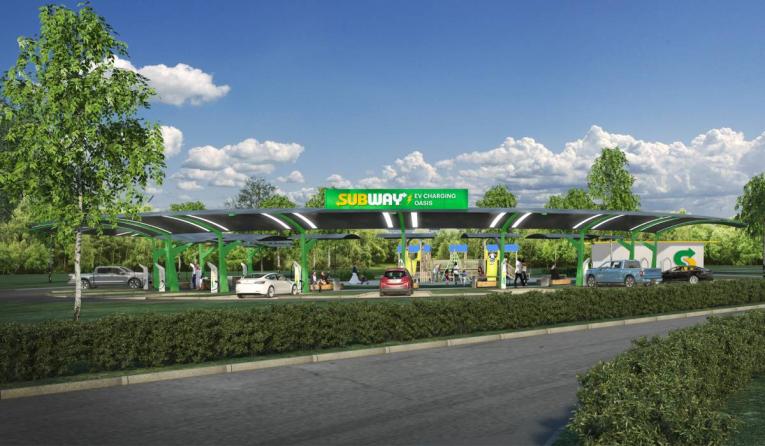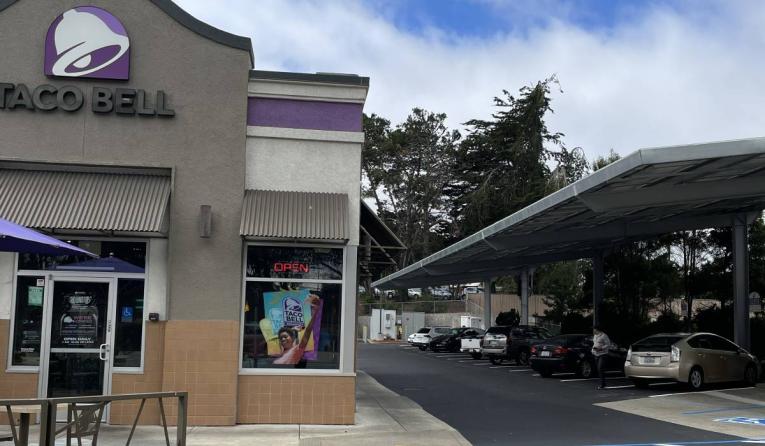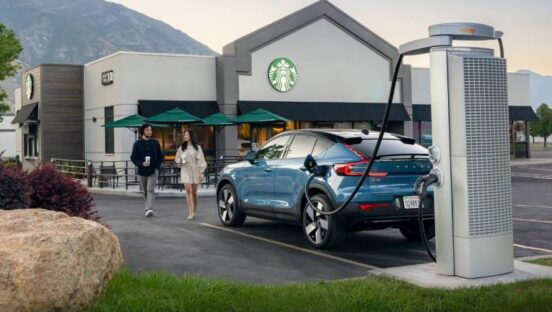The roar of gas-guzzling engines is slowly being replaced by the hum of electric motors. S&P Global Mobility projects that electric vehicles (EVs) could make up 40 percent of the country’s total car sales by 2030. Even more optimistic forecasts suggest that number could climb to over 50 percent.
With such rapid expansion in the EV market, the number of public charging stations will need to increase drastically to meet demand. S&P Global Mobility estimates the current number of chargers will need to grow by more than eightfold over the next six years.
According to federal data, there are more than 3 million EVs on the road and over 130,000 public charging stations across the country. The White House wants to grow the number of chargers to more than 500,000 via the National Electric Vehicle Infrastructure program (NEVI), a $5 billion initiative aimed at creating an accessible and convenient coast-to-coast charging network by 2030.
That’s where quick-service restaurants enter the picture.
“Unlike when you pull up to a gas station, where it takes five minutes to fill up your tank, EV charging takes more time,” says Abby Risner, an attorney at Greensfelder who works with clients in both the energy and franchising industries. “It’s a great opportunity for restaurants in particular to integrate an additional offer for their customers.”
With more than 20,000 restaurants across the country, Subway is the largest chain in the U.S. by store count. Chief operating and insights officer Mike Kappitt says the brand can use its “unmatched footprint” to help grow the country’s charging infrastructure. That’s why the sandwich chain is teaming up with GenZ EV Solutions and Red E Charging to build Subway Oasis charging parks.
“Our partnership will elevate the EV driver experience by offering canopies with several EV charging ports, picnic tables, restrooms, Wi-Fi, playgrounds, and green spaces,” Kappitt says. “The project is designed to offer added convenience for our on-the-go guests while doing good for the planet and generating incremental revenue for franchisees.”
To kick things off, Subway is working with its partners to install smaller charging stations this year. Those initial sites will feature fast chargers that provide a 120-mile charge in under 20 minutes for around $20.
“The pilot phase of the rollout will include smaller-format, fast-charging stations at select new or newly remodeled restaurants,” Kappitt says.
As an incentive for guests to plug in, Subway will offer dedicated promotions that are only available while utilizing the chargers. It plans to use insights from the pilot locations to shape its strategy for building out larger, more ambitious charging parks going forward.
“We are working closely with GenZ EV Solutions to determine the right format and number of locations for the Subway EV Charging Oasis parks, using research and guest insights, as well as considering the expected timeline for development based on market conditions,” Kappitt says. “Funding of the charging parks will vary per location and franchisee.”
Following the launch of an “eco-restaurant” model a decade ago, the move into EV charging is one of Subway’s biggest sustainability initiatives to date. It comes on the heels of a multi-year transformation journey that includes a focus on menu innovation, modernization of restaurants, and improvements to the overall guest experience.
“As part of our journey to be better, we’re taking a fresh look at how we make an impact on the world around us,” Kappitt says. “As a global company, sustainability is important to our brand and we’re committed to developing innovative solutions that will result in better living, better businesses, and a better planet.”

The idea that chargers ought to be located in places where people are likely to gather is an intuitive one. In practice, though, many chargers have been placed in remote parking lots or seemingly arbitrary locations. As EV adoption grows, charging will need to blend seamlessly with how consumers already live their lives, says Rebecca Wolkoff, co-founder and chief technical officer of ChargeNet Stations, a fast-charging station development and software startup. The company is working with Diversified Restaurant Group, a franchisee operating more than 300 Taco Bell and Arby’s locations, to install chargers at Taco Bell stores in California.
“It’s all about offering convenience and making ultra-fast charging available to everyone everywhere,” Wolkoff says. “More than 84 million people eat at quick-serve restaurants every day in the U.S. We want to go where the people are. Both quick-serve restaurant patrons and EV drivers appreciate convenience, quality, and value. With this partnership, we each provide that to our customers.”
Diversified Restaurant Group unveiled its first “electrified” Taco Bell store in South San Francisco last fall, and it’s working with ChargeNet Stations to install chargers at more than 100 additional restaurants throughout the Golden State. The sites pair ChargeNet’s software with fast-charging hardware from Tritium, an Australian EV charger manufacturer, which recently opened a factory in Tennessee that is capable of producing up to 30,000 Buy-America charger units annually.
“The technology is compatible with all EV connector types and offers, on average, a 100-mile charge in 15 minutes or fewer, for around $10,” Wolkoff says.
ChargeNet Stations is working with Diversified Restaurant Group to ensure a sizable portion of the charging stations are located “in and around underserved communities,” she says. That’s important for expanding access to charging where it is most needed in anticipation of cheaper and more widespread EV use in the future.
“We know there will be many people who don’t have access to convenient at-home charging, especially ultra-fast charging,” Wolkoff says.
Starbucks also is bringing much-needed infrastructure to underserved communities with its nascent charging network. The coffee giant last year teamed up with Volvo and the EV infrastructure company ChargePoint to install charging stations at its parking lots along a 1,350-mile route from Denver to Seattle. The thoroughfare passes through five states and several federal economic opportunity zones that are lacking in accessible public chargers.
The pilot program encompasses 60 DC fast chargers at 15 locations and is expected to be completed this summer. Starbucks will evaluate usage rates to decide if it wants to expand the service nationally as part of its broader goal to bolster renewable energy initiatives and cut its carbon footprint in half by 2030.
Like Subway and Diversified Restaurant Group, Starbucks is working with its partners to install direct current (DC) fast chargers. Those types of chargers are capable of charging an EV to 80 percent in well under an hour. They’re significantly quicker than Level 2 alternating current (AC) chargers, the other option that is commonly used in commercial applications, which take several hours to deliver a charge and is better suited for locations where drivers will remain parked for longer periods, like office buildings and hotels.

“More than 84 million people eat at quick-serve restaurants every day in the U.S. We want to go where the people are,” says Rebecca Wolkoff, co-founder and chief technical officer of ChargeNet Stations.
“The DC fast charger is the experience that you need for a quick-service restaurant,” says Alex Urist, director of business development at XCharge North America, a provider of smart grid and EV infrastructure solutions. “A Level 2 charger is not going to cut it, because you’re not going to charge nearly enough of your battery. Unless it’s an emergency situation, nobody is going to post up at a fast-food restaurant for three hours.”
The biggest hindrance preventing more restaurant operators from getting into the EV charging game is electrical service capacity. DC fast chargers typically require inputs of 480 volts and can’t be easily installed on the existing 208-volt service found in most quick-service locations.
“It’s not that you can’t get the service upgrade, because you certainly can,” Urist says. “But the cost of that upgrade is probably going to be far more than it’s worth and the revenue that you generate.”
Volvo and ChargePoint are overseeing the installation of charging stations at Starbucks stores, and they’re managing the complicated task of coordinating with local utilities to establish new electrical infrastructure.
Many EV charging stations, like those being built at Diversified Restaurant Group’s Taco Bell stores in California, feature solar panels and energy storage solutions that offset demand on the grid. ChargeNet says franchisees don’t need to make any utility service upgrades, except one additional meter needed to support the chargers. In fact, the company says operators can save up to 40 percent on their restaurants’ electricity by consuming the energy produced by the solar panels and stored in the battery system.
XCharge North America developed a DC fast charger that can be installed on a restaurant’s existing 208 service, enabling businesses to offer a fast-charging experience without bringing additional power to the site.
“Restaurants generally have a buffer on their capacity that would accommodate for at least one if not two chargers, thus making it so that there wouldn’t be significant infrastructure work necessary in order to get these into the ground,” Urist says. “It doesn’t have to be this charging oasis with 12 chargers in one block. I think the way to go about it is to think efficiently about what electrical service we have currently, and just plug a hole and fill a need across a web of assets.”
The cost for DC fast-charging hardware in the U.S. ranges from $28,000 to $140,000 per charger, according to 2019 estimates from the International Council on Clean Transportation. Depending on charger power and number of installed chargers per site, installation costs span $17,000 to $65,000.
An abundance of government incentives significantly lowers the cost of entry for businesses looking to help build up the country’s charging infrastructure. The Biden Administration has earmarked billions of dollars to facilitate the installation of public chargers, and tax credits are available to offset 30 percent of total project fees up to $100,000. Nearly every state and many utilities are encouraging commercial EV charging with rebates and grants, too.
ChargeNet Stations’ business model requires no investment from restaurant operators. The partnership with Diversified Restaurant Group leverages funding from several state incentive programs, so the franchisee pays nothing up front but still takes a cut of the revenue generated from the chargers.
Common pricing structures include by kilowatt-hour, by session, by length of time, or through a subscription. There are a number of different pricing models across charging network providers, including pricing for members versus non-members, site-host-specific pricing, and pricing based on rate of charge. There’s also user-specific pricing, like the model used at Starbucks, which offers free charging for Volvo drivers.
“The profitability question is one thing I’ve really wrestled with as we advise our clients on some of these issues,” Risner says. “It’s not difficult to see that in the very near future, some businesses will likely see an advantage of pulling customers to use the goods or services they were originally providing by allowing people to use the EV chargers for free.”
Today’s EV drivers may not push back on paying for the convenience of charging their car while filling up on a sandwich or a burrito, but there’s no guarantee that won’t change as more brands get into the EV charging game. More than a quarter of public charging already is free to use, according to the U.S. Department of Energy.
“Your profitability analysis shifts if it becomes a business value add-on,” Risner says. “I’m not hearing a lot of that conversation right now, but I really think it’s one that needs to be had. Are we going to be switching to an environment where most EV chargers don’t cost anything? That’s going to force you to reevaluate how profitable it is for your business.”
From car models to charging equipment to consumer expectations around the experience of being an EV driver, the wheels of change are turning fast. Risner says that creates both opportunities and challenges for restaurants looking to play a part in the green revolution.
“Whether it’s the lease for the equipment itself, your franchise agreements, the pricing structure, or whatever contractual relationships you have, make sure they account for the fact that this transition is going to develop quickly,” Risner says. “You’ll have to be willing to adapt as the space continues to develop, but I don’t know if that’s a reason to stay out of it, because then you may miss out on the opportunity.”









